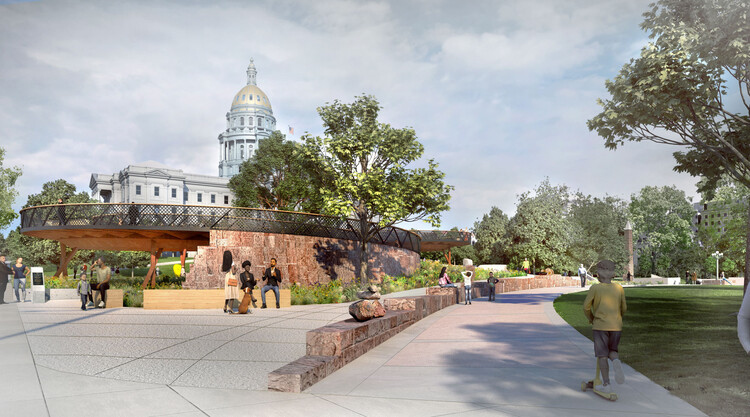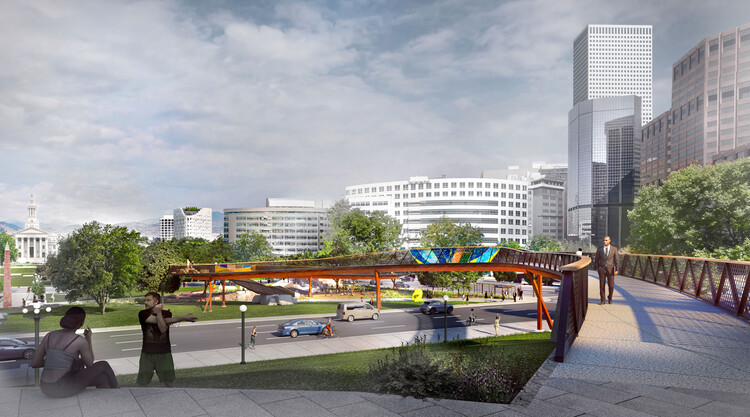
Studio Gang, led by Jeanne Gang, has revealed its design for the Colorado 150 Pedestrian Walkway, a new civic infrastructure project commissioned by Governor Polis and the America 150-250 Commission. Spanning 11,000 square feet, the walkway is conceived as both a connective urban thread and a commemorative landscape, marking the 150th anniversary of Colorado's statehood. Strategically sited in downtown Denver, the intervention links key public spaces and monuments, enhancing pedestrian accessibility while fostering a layered experience of art, culture, and history. Set to be completed by July 2026, various features, such as viewing platforms, monuments, new public artworks by Colorado-based artists, play areas, and interpretive elements, aim to invite users to explore, gather, and reflect along the route.
The project creates a pedestrian-oriented link between the Colorado State Capitol and Lincoln Veterans Memorial Park. For the first time, it offers an accessible route between these historically and politically significant sites. Situated within Denver's Civic Center, the walkway contributes to a broader revitalization effort in this central urban hub, recognized for its civic, cultural, and social functions. The site also holds historical significance in the disability rights movement, informing a design approach that prioritizes inclusivity for people of all ages and abilities.

The walkway's formal language draws inspiration from the geometry of Colorado's rivers, with a fluid configuration that adapts to the park's topography. It widens and narrows along its length, facilitating movement over Lincoln Street, a major downtown thoroughfare, and toward the elevated Capitol grounds. Its curving shape aligns with the park's historic crescent paths. Materials, including sandstone, marble, and granite, reference regional geological formations, reinforcing the site's cultural and environmental context.
Four programmatic zones organize the walkway experience. At its western edge, Park Landing reactivates an underutilized section of Lincoln Veterans Memorial Park with meadow plantings and a play area. Canopy Walk, the most elevated segment, integrates seating and public art while offering views of the Capitol and the Front Range. At the eastern end, Capitol Landing provides a newly accessible gathering plaza in front of the State Capitol. Environmental considerations also play an important role in the design. The pathway preserves existing trees by following an adjusted alignment and incorporates native plant species through new meadow installations. Durable, light-toned materials such as weathering steel and stone reduce heat absorption and long-term maintenance. The project is among the first to implement the Buy Clean Colorado Act, which sets global warming potential (GWP) thresholds for certain construction materials.

The Colorado 150 Pedestrian Walkway is being developed through a public-private partnership involving the Governor's Office, the P3 Office at the Colorado Department of Personnel & Administration, and History Colorado. It will act as a new civic gateway and complements several ongoing projects in the Civic Center area, including renovations to the Denver Central Library, upgrades to the Denver Art Museum, the recently completed Populus hotel, the planned 5280 Trail, and enhancements to the McNichols Building, Greek Theater, and Central Promenade, many of which are also designed by Studio Gang under the Civic Center Next 100 initiative.

Recently, Studio Gang also revealed the design for the Women's Leadership Center at Williams Bay, in Wisconsin, United States, a 24,000-square-foot retreat supporting professional women's programs, now under construction and set for completion in 2026, and has also begun work on the Samuel H. Scripps Theater Center in Garrison, New York, a 14,850-square-foot venue that will serve as the future home of Hudson Valley Shakespeare, set to open for the 2026 season.










